Hyundai Santa Fe v Mazda CX-8 v Volkswagen Tiguan Allspace comparison review
The days of packing your family into a Holden Commodore or Toyota Tarago are over. These are the new motoring staples for Aussie families. See how they compare.
car advice
Don't miss out on the headlines from car advice. Followed categories will be added to My News.
Australian motoring staples are having a tough time, with the likes of Toyota’s Tarago, the Ford Falcon, and Holden relegated to history.
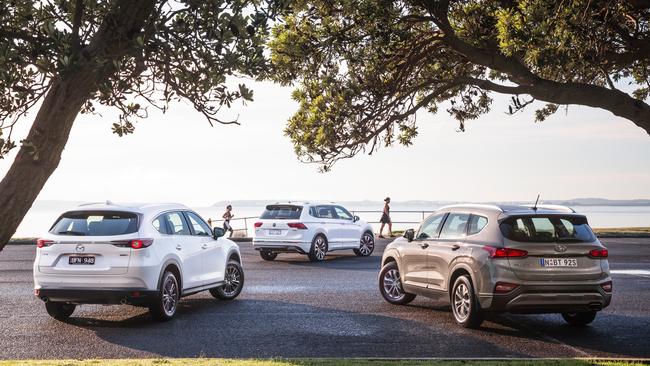
Growing families are gravitating toward SUVs, so we compared the new Hyundai Santa Fe V6 and fresh Mazda CX-8 petrol model with Volkswagen’s Tiguan Allspace.
Hyundai Santa Fe V6
This car ticks boxes for folks who miss the Toyota van or big Australian sedans. Powered by a lusty petrol V6, the big Hyundai offers space and grunt to spare.
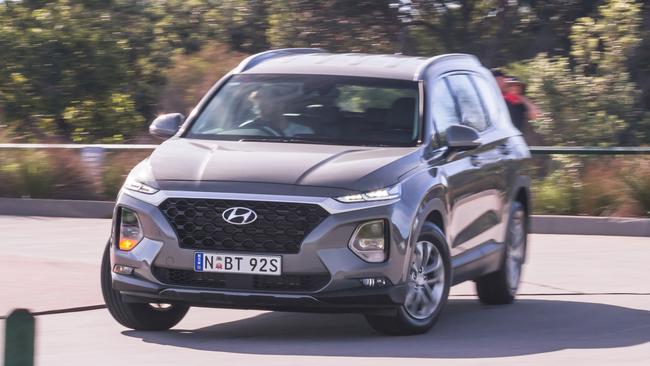
On sale for $44,490 drive-away in entry-level Active trim, this newest new Santa Fe variant ditches a four-cylinder diesel and all-wheel-drive for a powerful 3.5-litre V6 engine driving the front wheels.
The good news is it costs $4000 less while lifting peak power from 147kW to 206kW. On the other hand, you lose all-wheel-drive, the diesel motor has a 100Nm advantage over the petrol’s 336Nm torque peak and the petrol model needs more fuel.
This is the widest car of our trio, with an impressively roomy back seat and flat floor to improve passenger comfort. Second row occupants get USB outlets and an armrest, but not air conditioning controls in the budget version.
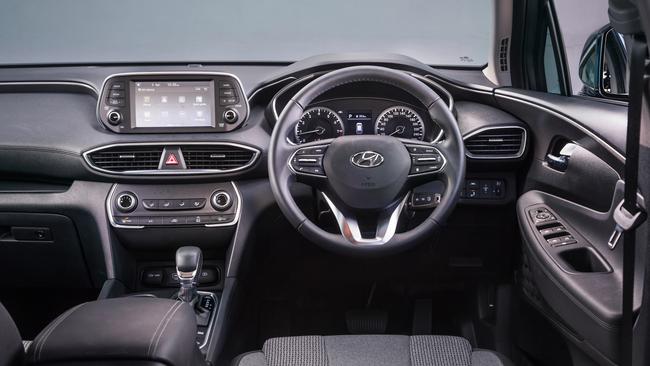
Hyundai customers get the smallest touchscreen here, a 7-inch unit loaded up with Apple CarPlay, Android Auto, and a reversing camera but no sat nav.
Clever one-touch access to the third row makes it easy for kids to clamber into the back, where they will find their own air vents and fan speed controls.
As with all three cars here, the Santa Fe has a five-star safety rating underpinned by modern technology such as autonomous emergency braking and active cruise control.
But it doesn’t have full curtain airbag coverage to the third row of seats, which are only partially protected by airbags covering the side windows.
The Santa Fe is the only car of the trio with a full-size spare, but it has less cargo space.
The engine feels mighty in this company, tugging up steep hills and along freeways with no fuss. Locally-tuned suspension delivers a pleasant driving experience which makes the big unit feel smaller than it should. Responsive steering and good composure over bumpy ground win points for the Hyundai.
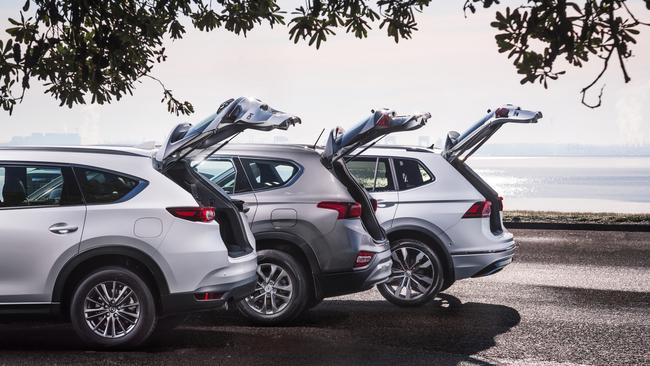
An eight-speed auto transmission is reasonably smooth, though it can second-guess itself. Wet conditions call for care on the throttle, as the big motor can easily overwhelm the front tyres.
An official consumption figure of 10.6L/100km means the Santa Fe won’t be cheap to run. At least Hyundai’s capped-price servicing scheme is good value at $1770 for five years, backed by a five-year warranty.
Customers get one year of roadside assistance, plus another year added on with each service performed at an official Hyundai dealer.
Mazda CX-8
Exclusively diesel-powered at its launch in 2018, Mazda’s CX-8 is now available with a 2.5-litre petrol engine. It’s not the turbo motor found in high-grade CX-5 and CX-9 models, as this new CX-8 Sport is positioned as a budget seven-seat option.
Priced from $41,490 drive-away, the CX-8 petrol costs $3250 more than an five-seat CX-5 and $4500 less than the bigger CX-9, making it the pick for some customers.
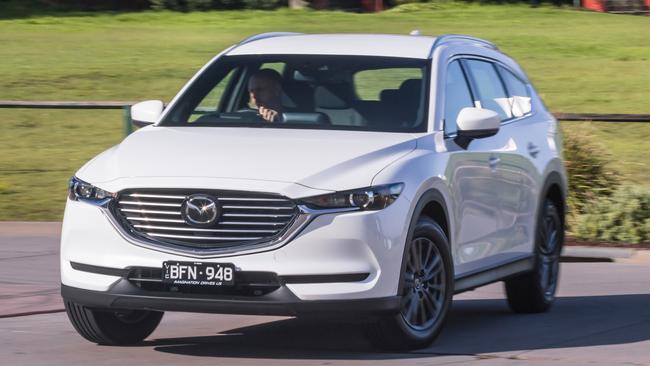
It’s also the cheapest to buy, slightly cheaper than the Hyundai to service, and the only car here that brings five years’ roadside assistance at no additional cost.
Long, tall and narrow, the CX-8 is the least stylish car in a Mazda showroom stacked with smart-looking machines.
But the interior looks upmarket, with an 8-inch infotainment screen and handy remote controller, along with nicer cabin plastics than the Hyundai.
And it is eminently practical, with the most spacious third-row accommodation of the cars assembled here.
While it misses out on the Santa Fe’s air vents, superior airbag coverage is an important point of difference.
Safety is a strong point for the Mazda, which builds on the Santa Fe’s suite by adding reverse automatic braking that could prevent you from backing over little ones in the driveway.
Three-zone climate control means second or third row customers are more likely to be comfortable, though kids will be disappointed to find there are no USB outlets for the back seat (which are reserved for the more expensive CX-8 Touring).
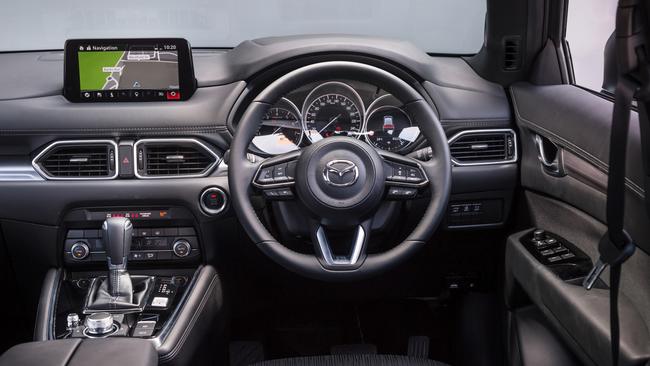
A pronounced transmission hump in the floor makes the Mazda feel more like a six-seater than a genuine seven-seat option.
Mazdas often represent a keen driver’s pick but that’s not the case here.
A noisy engine delivers less than stirring performance, working harder than the deep-chested Hyundai or turbo Volkswagen.
It doesn’t steer as sweetly as a CX-5 or CX-9, and that long wheelbase translates to an unsettled ride which can feel bouncy.
Mazda’s contender is also the noisiest of our trio on the road.
Volkswagen Tiguan Allspace
VW has an impressive new SUV in the Touareg, but it costs about $88,000 drive-away and only has five seats, so families might be more likely to gravitate to the Tiguan Allspace.
A stretched version of the popular Tiguan SUV with more room for passengers and a bigger boot, the Tiguan is the smallest of this trio.
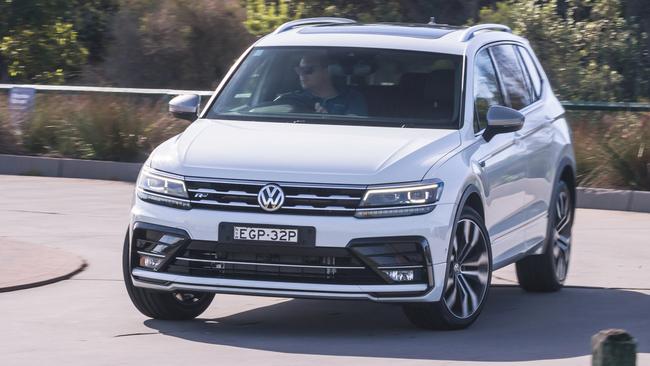
That means the third row is trickier to access than the ingenious Santa Fe, though cabin space is impressive once you’re inside.
Second-row passengers are spoiled with their own climate controls, plus USB and 12-volt power outlets, along with flip-down tray tables similar to those you’d find in a commercial airliner. Rear accommodation is impressively spacious, and VW’s reputation for quality cabins and clean looks is upheld by the Tiguan.
The standard Tiguan Allspace shown here is starting to feel a little dated, though you can change that by upgrading to premium models with a digital dashboard, massive 9.2-inch display and other toys reserved for more expensive versions.
Likewise, the little 1.4-litre, 110kW/250Nm motor here can be substituted in favour of a 162kW 2.0-litre turbo motor with AWD.
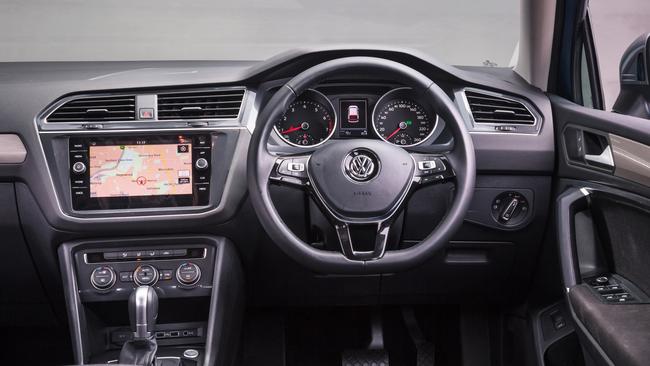
But the standard Tiguan Allspace priced from $41,990 drive-away will get the job done for most families. It’s a quiet and refined machine with quality features such as a powered tailgate, self-parking system and 18-inch alloys that aren’t available on rivals at this price.
The VW is the most expensive to service (budget on $2140 for five years), but uses much less fuel thanks to claimed 7.3L/100km economy. The frugality stems from the Tiguan’s size, as it undercuts the Hyundai and Mazda by more than 100 kilos.
It’s the most car-like to drive, with sweet steering and well-sorted if taut suspension that makes it the driver’s pick.
As with most new cars, it has a five-year, unlimited-kilometre warranty.
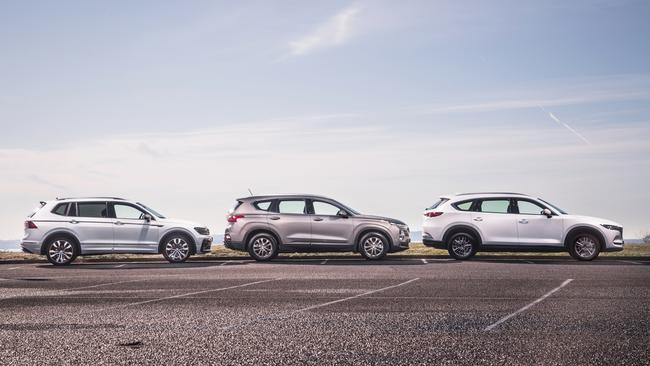
Verdict
If this was a performance car comparo, we’d probably pick the Hyundai, followed by the VW and Mazda. But these are family machines, so the order is reversed. As impressive as the Hyundai is, its higher price and greater thirst relegate it to third. The refined VW is a great middle option but perhaps a tad cosy for a seven-seater. The Mazda’s low running costs, top safety and generous space make it our pick.
Hyundai Santa Fe V6 vitals
Price: From $44,490 drive-away
Engine: 3.5-litre V6, 206kW/336Nm
Warranty/servicing: 5yrs/unlimited km, $1770 for 5 years
Safety: 5 stars, 6 airbags, AEB, active cruise control, lane keeping assistance, rear cross traffic alert
Thirst: 10.6L/100km
Cargo: 130 litres
Spare: Full size
Mazda CX-8 Sport vitals
Price: $41,490 drive-away
Engine: 2.5-litre 4-cyl, 140kW/252Nm
Warranty/servicing: 5yrs/unlimited km, $1737 for 5 years
Safety: 5 stars, 6 airbags, AEB, active cruise control, lane keeping assistance, rear cross traffic alert with auto braking
Thirst: 8.1L/100km
Cargo: 209 litres
Spare: Space saver
Volkswagen Tiguan Allspace 110TSI vitals
Price: $41,990 drive-away
Engine: 1.4-litre 4-cyl turbo, 110kW/250Nm
Warranty/servicing: 5yrs/unlimited km, $2140 for 5 years
Safety: 5 stars, 6 airbags, AEB, active cruise control, lane keeping assistance, rear cross traffic alert
Thirst: 7.3L/100km
Cargo: 230 litres
Spare: Space saver
Originally published as Hyundai Santa Fe v Mazda CX-8 v Volkswagen Tiguan Allspace comparison review
